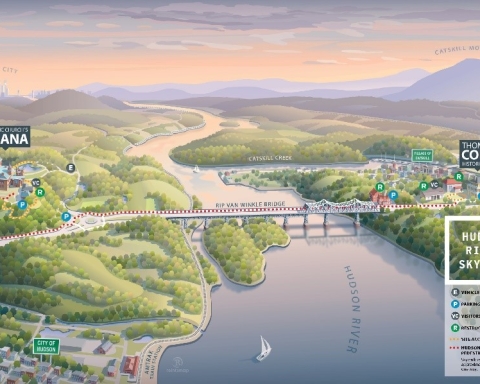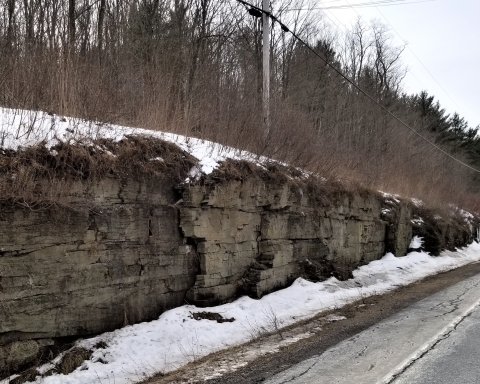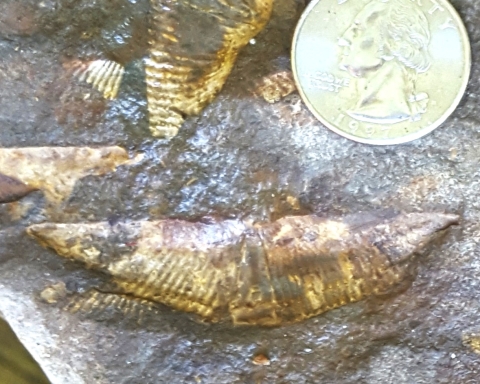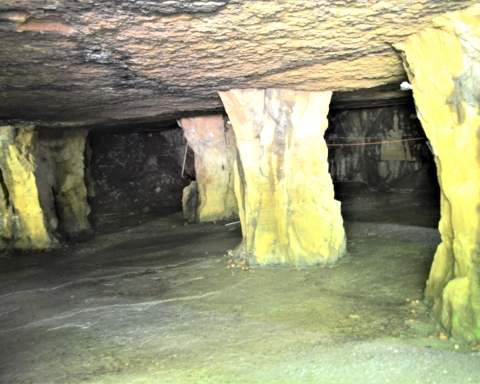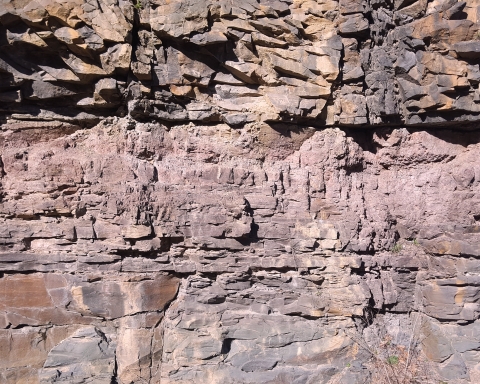The Devonian of Greene County, Part 4 – the Open Sea
The Greenville Press
Updated by Robert and Johanna Titus
Both of us have spent time in the Bahamas. One of the most exciting parts of the journey is the first-day plane ride across the Bahamian platform, that great wide shallow tropical sea that makes up most of the Bahamas. From the plane you can look down and see a wonderful, very shallow, tropical ocean. It’s a fabulous sight and the experience has equipped the two of us to see the Catskills in a way that not many can. A plane ride across the Bahamas is also a flight across our land as it was long ago.
Sunrise, October 31, 410,390,139 BC, just before dawn – Weare the mind’s eyes; we can go anywhere and do anything. We can go fast, and we can go slow, we can soar high and we can fly low. Right now, we are a mile above the future site of Stamford, and we are headed east. The sun is, of course, headed west and we watch as the gray eastern horizon brightens into a red and then a yellow. We can see a brightness that betrays exactly where the sun is, even if it still remains hidden below the horizon.
Below us is the grand expanse of a great broad sea. It is called the Helderberg Sea, but it is still too dark this morning to actually see it. Behind us, the last of the morning stars are still shining but before us the sky continues growing brighter and suddenly a red pinpoint of light expands into the full disk of a rising sun. We, the mind’s eye, pause and hang still in the sky and watch this daily cycle of light. Soon it will be bright enough.
The rising Sun reveals that, below us and stretching to the east, is a beautiful shallow sea. This ocean can’t be very deep. The water is clean and transparent, but the seafloor is just a little too deep to be clearly visible. Nothing much of it can be seen even this high up, but we are the mind’s eye and we descend down to an altitude of merely 50 feet above the waters. The morning air is still and already warm; the water is undisturbed by any waves. We slowly move across the aqua-colored sea and gaze through the waters of the Helderberg Sea down to its bottom. There are a few fine patches of green. Large seaweeds and sea grasses do not exist yet in this the Devonian time period and it is too deep here for most algae. Nevertheless a few “fronds” of algae rise from the seafloor and make up small green patches.
We, the minds eye, now are drifting across the sea. It is as if it was given to us to be in a glass bottomed boat, but this boat travels across a 410 million year old ocean. It is fascinating to see the past like this.
Now, we cross a stretch which appears to be a marine meadow. The seafloor is not covered with our algal greenery but, rising above that, are what appear to be flowers. We drop into the sea and go down to the bottom and look. We are the mind’s eye and we can do this.
Our “flowers” turn out to be animals; they are called “crinoids” in the Latin terminology, but many people like to just call them “sea lilies” as that is what they look like. They are distant cousins of the starfish. Their brightly colored arms reach up into the waters of the Helderberg Sea as they search for food. There is a lot of food and, not surprisingly there are many crinoids too. They truly make up something that looks like a meadow.
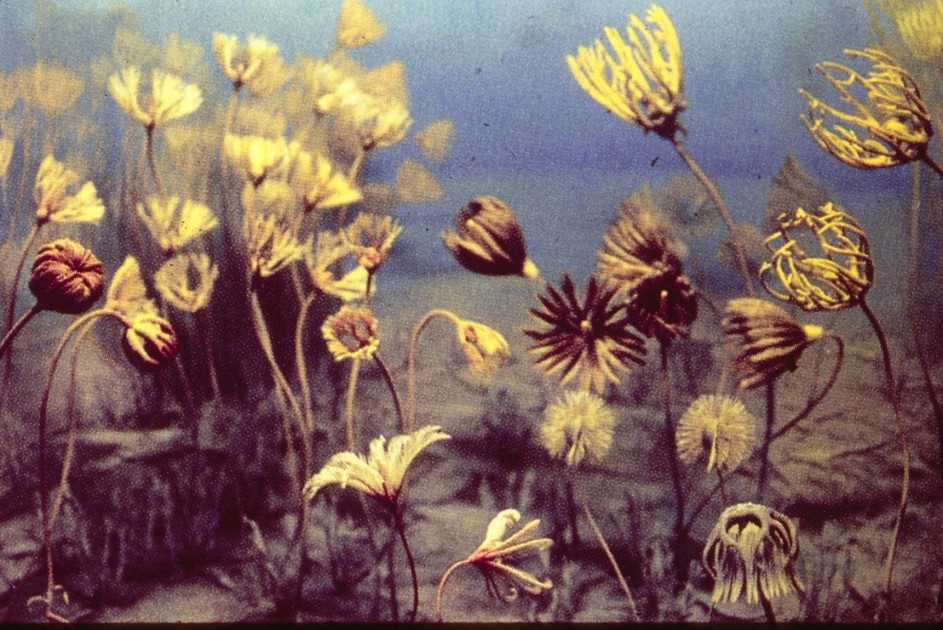
Our “meadow” is something of a marine jungle and it is not without animals lurking in the “brush.” Shellfish, that paleontologist call brachiopods, are the most common. Then there are the delicate lacy networks of animals called bryozoa, Latin for moss animals. Both of these forms appear sporadically among the green algae. The most interesting of our Devonian animals are the trilobites. They might remind you of a horseshoe crab. One of them is slowly creeping through our meadow. It is clawing at the sediment beneath. This form is a scavenger and it is seeing what sort of food luck has in store for it. We, the mind’s eye, are fortunate enough to see this one alive.
The brightest of the Devonian animals were the nautiloids. We see them and quickly recognize that they were related to the squids. They had the long tentacles and the fine eyesight that modern squids have and were actually close cousins with the modern forms. The two groups were similar except that, unlike squids, the nautiloids “wore” shells. Some of those were conical, but the ones we are looking at are coiled. Our Helderberg specimens seem to be social. Six of them lull on a patch of sandy sea bottom. Their tentacles paw back and forth through the sand; they too seem to be searching for food.
We have spent hours drifting lazily across the Helderberg seafloor, but we have covered a lot of ground. Now we have arrived at a spot where someday Rte. 23 will pass the Thruway. Our journey into the Devonian is not over however; our travels will simply take a different route. Now we will travel about 400 million years forward through time, but when we get there, to today’s world, we will still be in the Devonian.
May 16, 2004 – Rte. 23, south side of the road, just east of the Thruway – Traffic speeds by this spot 24 hours a day. Cars rarely stop here; there are few reasons to do so. The only thing of note here are the ledges of gray limestone that line both sides of the road. The rocks have a name: geologists say that they belong to units called the Kalkberg and the overlying New Scotland Limestones. To the discerning eye, these sedimentary rocks are composed of sandy textured materials which were once, indeed, sands. These are not the quartz sands that we know in the northeast; they are soft calcium carbonate sands that harden into limestone.
The Kalkberg and New Scotland are stratified; the rocks are composed of horizontal layers of limestone. What is remarkable is that each horizon of rock was once, for a short time, the bottom of the Helderberg Sea. Each horizon had its turn as seafloor; its sediments were laid down by passing currents. Then, for a time, warm waters lapped across them. Algae and shellfish took their turns living here. But “turns” are always brief; soon these temporary seafloors were buried by more sediment carried by more currents. When the weight of burial was great enough, they slowly hardened into rock. This describes the almost endless cycle of sedimentation.
That sea was deepening, and the New Scotland was deposited in deeper waters than the Kalkberg. Geologists call this a “transgressing” sea. We have been seeing this record of transgression in the several articles that we have been writing. The transgression first began with the appearance of the Manlius Limestone. The Helderberg Sea gradually deepened through the sequence of the Coeymans, Kalkberg and New Scotland Limestones. With deposition of the New Scotland the deepening would reach a maximum and the Helderberg Sea would not get any deeper. But it is important to understand that “deep” is relative; this was never anything but a shallow tropical sea, much like the Bahamas of today.
If you visit a place such as this, you can search out horizontal ledges of limestone. When you look at such surfaces, you are looking into the past. You are literally looking at ancient seafloors. Often these surfaces are littered with the fossils of the very shellfish that once lived here. These creatures have been dead for about 410 million years, but they were the living creatures who actually knew the Helderberg Sea when it covered most of upstate New York
Those surfaces can still be littered with the fossils of brachiopod, bryozoa, crinoids, trilobites and much more. In a way the Helderberg Sea is still alive, but only to those who know where and how to look.
Contact the authors at randjtitus@prodigy.net. Join their facebook page at :The Catskill Geologist.

